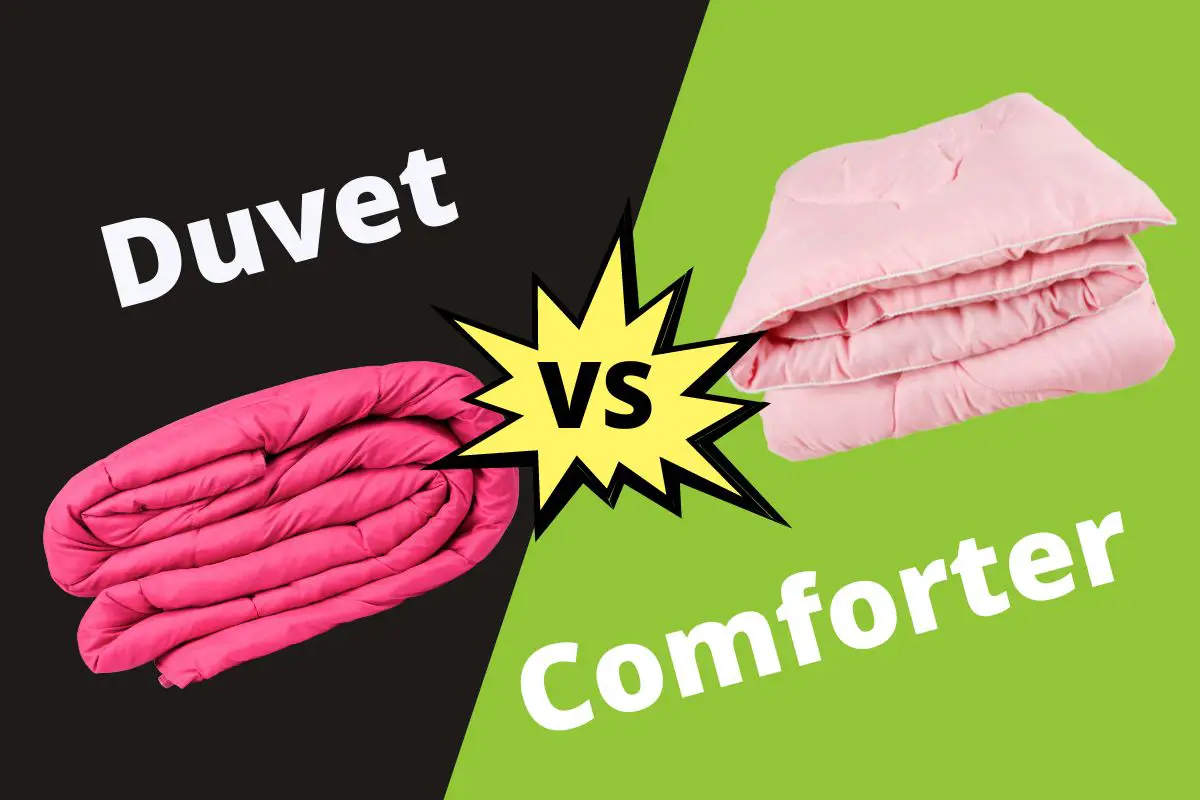The main difference between a duvet and a comforter is their design. While a comforter is designed to be used as one complete piece, a duvet is designed to be used with a coverlet, duvet cover, or top quilt.
Comforters and duvets are popular bedding items that make you feel comfortable and warm on cold nights. While these two types of bedding have many similarities, their differences can change the buying preference.
Table of Contents
Differences Between Duvet and Comforter
| Duvet | vs | Comforter |
| Depends on its construction, materials, and care A 300-thread count encased high-quality filled duvet may last longer. Requires occasional re-fluffing. |
Durability | Depends on its construction, materials, and how you care for it. Used without a cover, so staining is possible, limiting their life span. |
| Duvets are thicker, heavier, and warmer than comforters. | Warmth | Comforters are usually thinner than duvets, so they’re often not as warm as duvets. |
| Duvets of artificial materials are affordable, but traditional down duvets are expensive. Duvet covers lead to extra expenses. | Cost | Depends on materials. However, they are more affordable when accompanied by other bedding. |
| Duvet covers are available in various options and can be styled according to season and mood. | Style | Do not come with a cover and are mostly bundled with other beddings, giving a broad spectrum of colors and patterns to suit different aesthetics. |
| Lighter, so easier to clean after removing the cover. | Care | Bulky, so it’s difficult to clean. |
What is a Duvet?
Duvet is a top layer or top sheet of two-piece bedding stuffed with synthetic fiber and paired with a removable and washable cover.
The word duvet is a French word that means soft comforter or down comforter.
It originated in Europe, and earlier, it was stuffed with soft, fluffy geese and duck-down feathers that naturally insulated heat to give warmth during cold winter nights. Other stuffing options include microfiber, firmer feathers, and polyester.
Modern duvets are available in many designs, colors, and materials, such as cotton, silk, flannel, and blends. Most duvets are available in white or off-white color.
Duvets come with a protective covering called a duvet cover sealed with buttons, ties, or zippers.
Duvet Coverlet
A coverlet is a non-reversible quilted or top woven blanket.
It is used as a decorative layer over a thick duvet or comforter. However, it is not attachable. For example, a duvet coverlet is a common sight on hotel room beds to add an aesthetic touch.
Duvet Pros and Cons
Buying a duvet is essential, so let’s understand the pros and cons of this unique bedding style.
Pros of a Duvet
- A duvet can be cleaned easily (manually or by machine)
- It has a lightweight fabric and fluffy texture
- It is versatile, and the cover can be changed according to the season
- The duvet cover can also be replaced, if stained
- It enhances the look of the bedroom decor
- It is made of long-lasting materials
- Duvets are mostly affordable
Cons of a Duvet
- It can be challenging to assemble
- Duvet fillings can clump up sometimes
- Provide less coverage for all sleepers

What is a Comforter?
A comforter is a single-piece fluffy, thick blanket stuffed with synthetic fiber without a cover. These are available in a variety of designs, patterns, and colors. Bedding sets with sheets and pillowcases accompany them.
Comforters have fewer stuffings and are lightweight. Because they’re less fluffy, you’ll probably need to use a quilt with it during cold nights.
Comforter Pros and Cons
Before buying a comforter, it’s essential to know its pros and cons.
Pros of a Comforter
- A comforter comes with evenly distributed stuffing
- It provides good coverage
- It doesn’t require assembling
- The comforter is available in matching bed sheets and pillowcases
- You don’t need any covers
Cons of a Comforter
- A comforter is challenging to clean because of its large size
- It won’t provide enough warmth on cold winter nights
- It often gets flattened over time

Duvet vs Comforter – Key Differences
Here is a quick comparison between the two products on various parameters.
Durability
The durability of a duvet and comforter depends on its construction, materials, and how you care for it.
A 300-thread count encased high-quality filled duvet may last longer. However, it requires occasional re-fluffing.
Comforters are used without a cover, so staining is possible, thus limiting their life span. However, if covered, a high-quality comforter can last longer.
Warmth
Duvets are thicker, heavier, and warmer than comforters. In contrast, comforters are usually thinner than duvets, so they’re often not as warm.
Cost
Duvets of artificial materials are affordable. However, traditional down duvets are a bit expensive. Also, the duvet cover leads to extra expenses.
Based on the materials, the price of a comforter can vary. However, they are more affordable when accompanied by other bedding.
Style
Duvet covers are available in a variety of options. They thus can be adjusted and replaced according to season and mood.
Comforters do not come with a cover and are mostly bundled with other bedding, thus giving a broad spectrum of colors and patterns to suit different aesthetics.
Care
A duvet is easier to clean after removing the cover. In contrast, comforters are bulky, so cleaning them isn’t easy.
Which Will You Choose?
The critical difference between a duvet and a comforter is that while a duvet is designed with a separate cover, a comforter is designed with a built-in cover.
Choosing between a duvet and a comforter is a matter of preference.
Before buying any of them, consider price, purpose, personal style, caring approaches, loft, warmth, and more.
If you’ve enjoyed this article, check out our post on the difference between condos and apartments.

